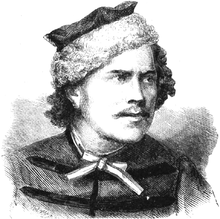Boleslovas Kolyška
Boleslovas Kajetonas Kolyška | |
|---|---|
 | |
| Nickname(s) | Rutkowski, Szyszka |
| Born | 7 August 1837 [1][2] |
| Died | 9 June 1863 Vilnius |
Boleslovas Kajetonas Kolyška alias Rutkowski, Szyszka (Polish: Bolesław Kajetan Kołyszko; 1838[1] – 9 June [O.S. 28 May][1] 1863) was one of the leaders in the January Uprising.[1]
Early life[]

Kolyška was born into a petty noble family as a son of Wincenty Kołyszko and his wife from the Jursza family.[2] He had an older brother, Feliksas Kolyška, who also fought in the January Uprising.[1] Boleslovas Kolyška graduated from the Vilnius Gymnasium and studied law in the University of Moscow.[1][2] According to Dawid Fajnhauz, he might have graduated from instead of Vilnius.[2] In the University of Moscow, Kolyška was part of the Polish students association called "Ogół".[2] He was arrested in 1861 for his involvement in student demonstrations in Lida.[2] At the end of 1861, after a short imprisonment, he emigrated to Italy, where he met Ludwik Mierosławski.[2] First in Genoa and later in Cuneo, he studied in the .[1][3] Although the Military School acquainted Kolyška with the military, it was impossible to develop his military talent or even qualify him for a commander in such a short time.[4]
Uprising of 1863[]
After the start of the uprising he went back to Lithuania.[1] On 21 March 1863, he began the uprising between Čekiškė and Panevėžys.[1] In a few days, his unit included 400 men and was also joined by the unit led by the priest Antanas Navaina.[1] As he organized the rebel group near Kaunas during March, it was joined by the groups of and .[5] The combined group was called the Dubysa Regiment.[5] The regiment had three battalions, with the battalion commanders being Bronislavas Žarskis, Antanas Norvaiša and Juozas Radavičius.[4] Kolyška led his 400 men strong regiment[3][4] in fights against units of the Imperial Russian Army at Aukštdvaris on March 29-30.[1][5] He then fought near Lenčiai on April 1 (together with the unit of Tomas Kušleika), near on April 11.[5]
By Zygmunt Sierakowski's order, he led a rebel column - two battalions and a cavalry unit that fought in the battle of Biržai. On May 7, Kolyška was the first from the rebel columns to reach the designated spot, .[6] They were attacked by Russian forces, but when Sierakowski came and joined the battle, the Russian attack was repelled.[6] Kolyška and Sierakowski's aide-de-camp were supposed to take wounded the Sierakowski and transport him out of the country, but they were captured on May 10.[3] During the interrogation he blamed Sierakowski for the uprising's failure and underlined that he was doing everything for the homeland.[3] He was hanged by a court-martial on June 9, 1863.[7][8]
The remains were secretly buried in Vilnius' Gediminas' Hill. They were found in 2017 during the works designed to strengthen . On 22 November 2019, the remains were solemnly buried in the Columbarium of the Rasos Cemetery in Vilnius.[9]
Sources[]
- ^ a b c d e f g h i j k Čepėnas 1957, p. 223.
- ^ a b c d e f g Fajnhauz 1968, p. 368.
- ^ a b c d Fajnhauz 1968, p. 369.
- ^ a b c D. c. n. 1864.
- ^ a b c d Istorikas.lt 2013.
- ^ a b Kupiškio etnografijos muziejus 2021.
- ^ Maksimaitienė 2006, p. 372.
- ^ Bairašauskaitė 2019.
- ^ kam.lt 2019.
Bibliography[]
- Čepėnas, Pranas (1957). "Boleslovas Kolyška". Lietuvių enciklopedija (in Lithuanian). Vol. 12. Boston. p. 223.
- Fajnhauz, Dawid (1968). "Bolesław Kołyszko". Polski Słownik Biograficzny (in Polish). Vol. 13. Wrocław. pp. 84–85.
- Maksimaitienė, Ona (2006). "Boleslovas Kajetonas Koliška". Visuotinė lietuvių enciklopedija (in Lithuanian). Vol. X (Khmerai-Krelle). Vilnius: Mokslo ir enciklopedijų leidybos institutas. p. 372.
- Istorikas.lt (30 September 2013). "Kolyška Boleslovas Kajetonas" (in Lithuanian).
{{cite web}}: CS1 maint: url-status (link) - Bairašauskaitė, Tamara (2019). 1863-1864 m. sukilėlių kelias į mirtį ir atgimimą (in Lithuanian). Vilnius: National Museum of Lithuania. ISBN 978-609-478-031-8.
- kam.lt (22 October 2019). "1863–1864 m. sukilimo vadų ir dalyvių valstybinių laidotuvių ceremonija vyks 2019 m. lapkričio 22 d." (in Lithuanian).
{{cite web}}: CS1 maint: url-status (link) - Kupiškio etnografijos muziejus (2021). "1863 – 1864 m. sukilimo keliu po Šiaurės Rytų Aukštaitiją". etnografijosmuziejus.lt (in Lithuanian).
{{cite web}}: CS1 maint: url-status (link) - D. c. n. (19 December 1864). "Monografja oddziałów powstańczych na Żmudzi" [A monograph of insurgent units in Samogitia.]. (in Polish) (124) – via cyfrowe.mnk.pl.
- 1838 births
- 1863 deaths
- Lithuanian Army officers
- January Uprising participants